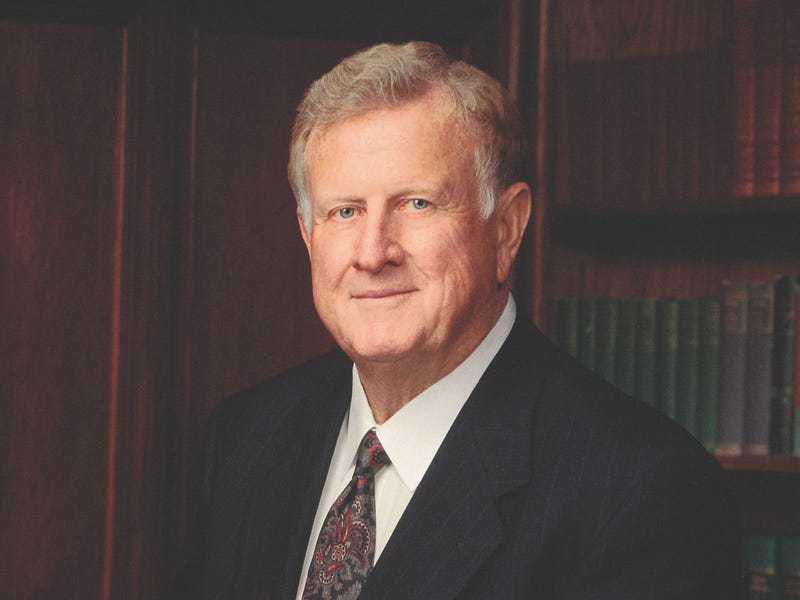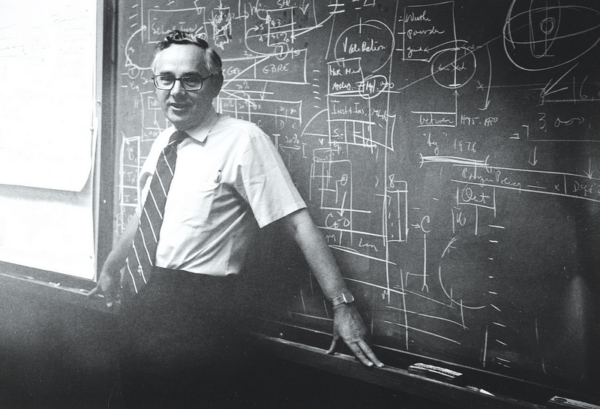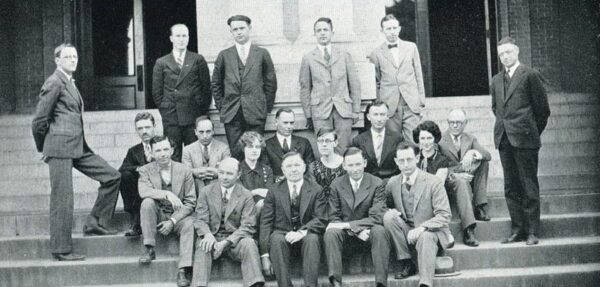Big Dreams and Red-Hot Connections
How 25 years of entrepreneurial energy changed the trajectory and brand of business at McCombs.

and pledges to help fund construction.
By David Wenger
A correspondence began in the late 1990s between Bob May, the McCombs dean from 1995 to 2002, and a larger-than-life true Texas legend in the late 1990s. Billy Joe “Red” McCombs attended UT Austin in the late 1940s and in legendary fashion went on to launch a sprawling portfolio of over 400 business interests, including automobile dealerships, communications ventures, professional sports, oil, ranching, and real estate.
At the time, Red McCombs was already a known UT philanthropist, giving $3 million in 1997 for a new women’s softball complex. The dean invited him to speak to students at the business school, and things seemed to click. McCombs left the school “glowing,” recalls May. In 2000, he and UT President Larry Faulkner called on the Texas magnate in his San Antonio office, where McCombs surprised them with an unexpected question. “If you had $50 million with no strings attached, what would you do with it?”
May and Faulkner were stunned and nearly speechless. “No strings attached” was an entrepreneurially bold challenge. Most large contributions to the university are earmarked for specific initiatives. McCombs’ offer had no restrictions at all. Monies could be used to fill
urgent, immediate needs while also providing matching funds for future projects, sparking previously unthinkable levels of giving from other philanthropists.
And just like that, the business school gained $50 million, a billionaire supporter, and a new name. “My hope is that this gift will allow the school to be one of the very best in the world, period,” Red McCombs said at the May 11, 2000, announcement of his gift. It soon became apparent that he was willing to put more than money behind that dream.

“Red and his love for learning and the university had a big impact on our family. There’s a good chance we wouldn’t have even made the gift if Red hadn’t let the way.” —Robert Rowling, BBA ’76
The school’s largest donor became a frequent visitor to campus. Speaking and listening to students, he personally kicked off annual student campaign drives and lent his burnt orange influence to encourage other philanthropists to join his vision for the school.
A Century Path From Wooden Shacks to World-Class Capacity
McCombs’ generous and audacious gift empowered the newly named Red McCombs School of Business to think big while starting a chain reaction that pushed the school to take giant leaps forward during a fourth quarter-century of explosive performance and reputational growth.
Tapping the power of private millions was unthinkable in the early days of the public university. James Anderson Fitzgerald, who was the University of Texas business school dean from 1926 to 1950, arrived on campus to find surprising deprivation.
“No electric fans were available in any classrooms,” the new professor recounted. “The accounting library and business administration classrooms were housed in a pine board shack. I conducted an afternoon class in which I perspired so freely that my socks collected salt deposits around my ankles.”
Fitzgerald’s pleas for ceiling fans went unfulfilled, as summer school funds, he was told, were barely adequate to meet staffing needs.
One can imagine Fitzgerald’s amazement were he to stroll through the soaring light-filled atrium of Rowling Hall today or witness a class taught in an adaptable (and comfortably air-conditioned) in-person and remote classroom. No sweaty socks here, professor.
The school’s early founders probably would be surprised to learn that the vision and generosity of the school’s business partners and alumni —
including some who rocketed to fame — were instrumental to the school’s
funding and its future.
Private Funding for a Public Education Mission
Private donors became increasingly essential to the school’s rise as the constrained realities of public funding no longer meshed with the founders’ aspirations of creating a “University of the first class.” In 1958, a report issued by the Committee of 75 warned: “While the University
Permanent Fund is a tremendous asset for The University of Texas, the almost legendary stories that have grown up around it have worked also to The University’s detriment. To an appreciable extent, private and industrial grants have been discouraged because many think that ‘The University doesn’t need the money.’”
In other words, the university had become a victim of its own success. But the need for private investment was soaring as the state’s share of overall funding was falling to today’s level of 23% for state/county support, of which 12% is the state endowment, called the AUF (auxiliary university fund).
Declining state aid was evident as UT’s centennial approached in 1983, even as strong oil production temporarily swelled the returns on the Permanent University Fund endowment. Then-President Peter Flawn persuaded the UT System Board of Regents to use a portion of the surplus for a matching fund campaign. Private donors could double their gift using university matching funds or create a new endowment of equal size in the same or another college or school at UT.
Bill Cunningham, dean from 1983 to 1985, describes the early days of the Centennial Endowment campaign. “I remember going to my first Business School Foundation meeting … I was sitting next to the chairman, and he turned to me and said, ‘What’s your goal for the business school?’ I said, ‘Twelve. $12 million.’ There was no science behind that number, but I was going to show the world that I was prepared to do what I could do to make it a better place.”
In two years, the school had raised $24 million for endowed faculty positions, including funding for other colleges at UT. This one-time
opportunity to transform income from the Available University Fund
into chairs and professorships marked a new philosophy of private partnership that changed how the university, private businesses, and
philanthropists thought about their relationship and the possibilities for shared returns on investment.
From then on, new deans bolstered by school development officers assumed duties for private fundraising in addition to running the school.
With that added burden came the possibility of accomplishing dollar-intensive goals that earlier educators could not have fancied. The school’s business co-creation skills, fostered under George Kozmetsky, combined with private funding zeal, ushered in the subsequent fourth quarter-century of the business school with a Red-hot bang.
1,000 Endowments By the Numbers
McCombs’ Centennial celebration has happily coincided with our 1,000th
endowment, as the Russell Owens’ Dean’s Scholarship was approved by the Board of Regents. McCombs is inspired by and grateful for 100 years of generosity from students, parents, alumni, faculty, staff, and other corporate and institutional supporters.
First Endowment Established
1928
100 Years of Endowed Support
$245,918,759
Total Market Value
$483,163,639
Endowment Awards
19,000
Total Faculty, Students, and Programs Supported
9,300
Individual Gifts
60,000+
Donors, Corporate Partners, and Matching Programs
19,000
David Wenger was the director of communications at McCombs from 2006 to 2019.
This article appeared in the Centennial 2022 issue of McCombs magazine. Click on the link to see the full issue.


